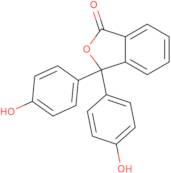
Phenolphthalein
CAS: 77-09-8
Ref. 3D-FP52658
| 1kg | A consultar | ||
| 2kg | A consultar | ||
| 100g | A consultar | ||
| 250g | A consultar | ||
| 500g | A consultar |
Información del producto
- 3,3-Bis(?-hydroxyphenyl)phthalide3,3-Bis(4-hydroxyphenyl)-1(3H)-isobenzofuranone
- 3,3-Bis (P-Hydroxy-Phenyl)-Phthalide
- 3,3-Bis(4-hydroxyphenyl)-1-(3H)-isobenzofuranone
- 3,3-Bis(4-hydroxyphenyl)-2-benzofuran-1-one
- 3,3-Bis(4-hydroxyphenyl)phthalide
- 3,3-Bis(p-hydroxyphenyl)phthalide
- 3,3-Bis-(4-hydroxy-phenyl)-3H-isobenzofuran-1-one
- Euchessina
- Fenolftaleina
- Isobenzofuran-1(3H)-One, 3,3-Bis(4-Hydroxyphenyl)-
- Ver más sinónimos
- Koprol
- Laxogen
- Lilo
- Nsc 10464
- Nsc 215214
- Phenolphtaleine
- Phenophthalein
- Phthalimetten
- Phthalin
- Purga
- Purgen
- Purgophen
- Px 0520-1
- Spulmako-lax
- Trilax
- Ty 9
Phenolphthalein is a chemical compound that is used as a pH indicator. It changes color from colorless to pink in the presence of an acidic solution, and from pink to colorless in the presence of an alkaline solution. Phenolphthalein has been shown to be carcinogenic in animal models, but this effect has not been observed in humans. This product has low toxicity and can be used as a nutrient solution for plants. Phenolphthalein is also genotoxic, meaning it damages DNA, and may cause cancer or genetic mutations.
The mechanism of phenolphthalein's reaction with p-nitrophenyl phosphate (pNPP) is poorly understood. The most common hypothesis suggests that phenolphthalein reacts with pNPP by forming a reactive intermediate that reacts with oxygen to form hydrogen peroxide and p-nitrophenol (pNP). This reaction produces two molecules of water as well as an unstable intermediate that decomposes into
Propiedades químicas
Consulta técnica sobre: 3D-FP52658 Phenolphthalein
Si desea solicitar un presupuesto o realizar un pedido, por favor añada los productos deseados a su carrito y solicite un presupuesto o pedido desde el carrito. Es más rápido, más barato, y podrá beneficiarse de los descuentos y las ventajas disponibles.





